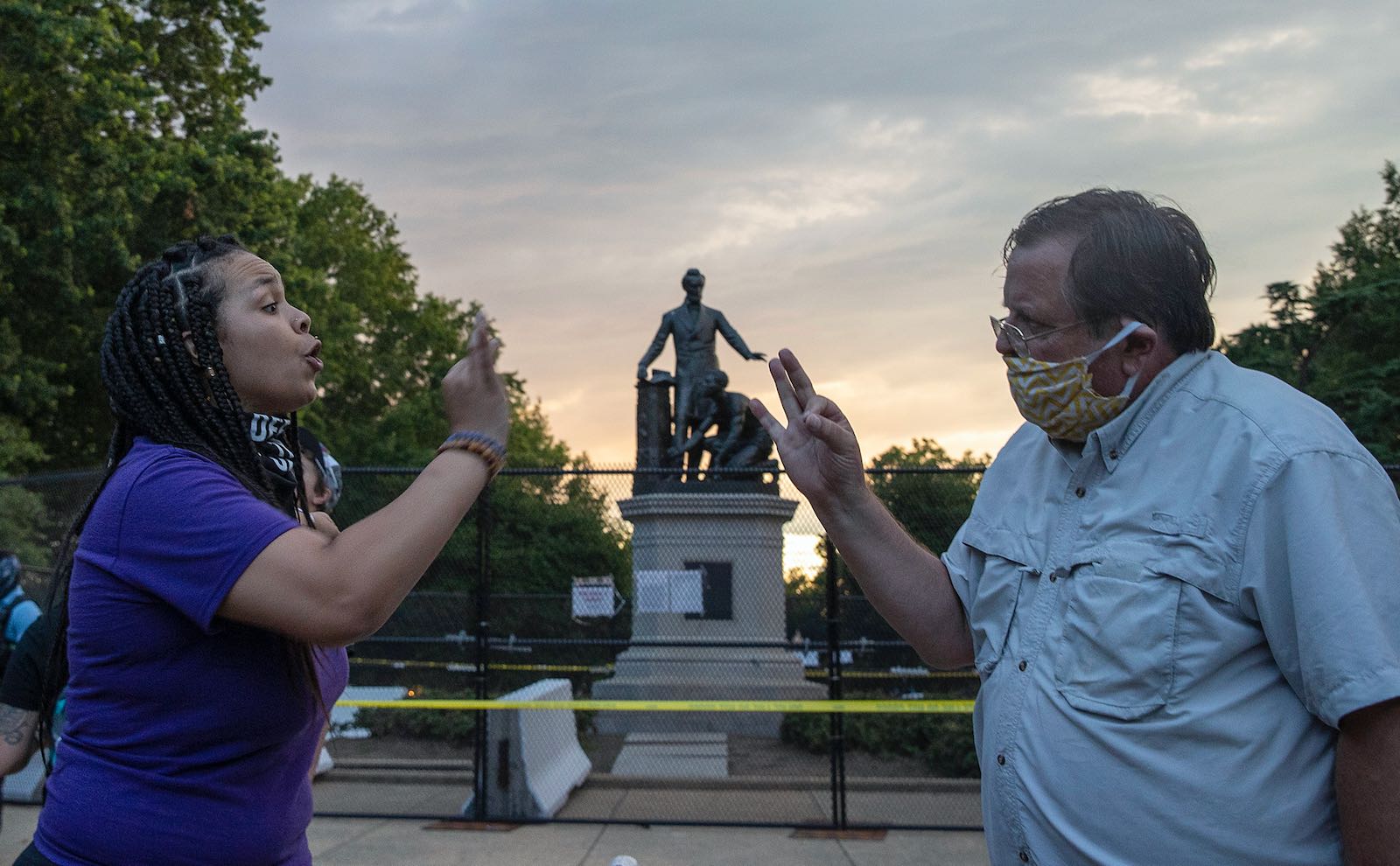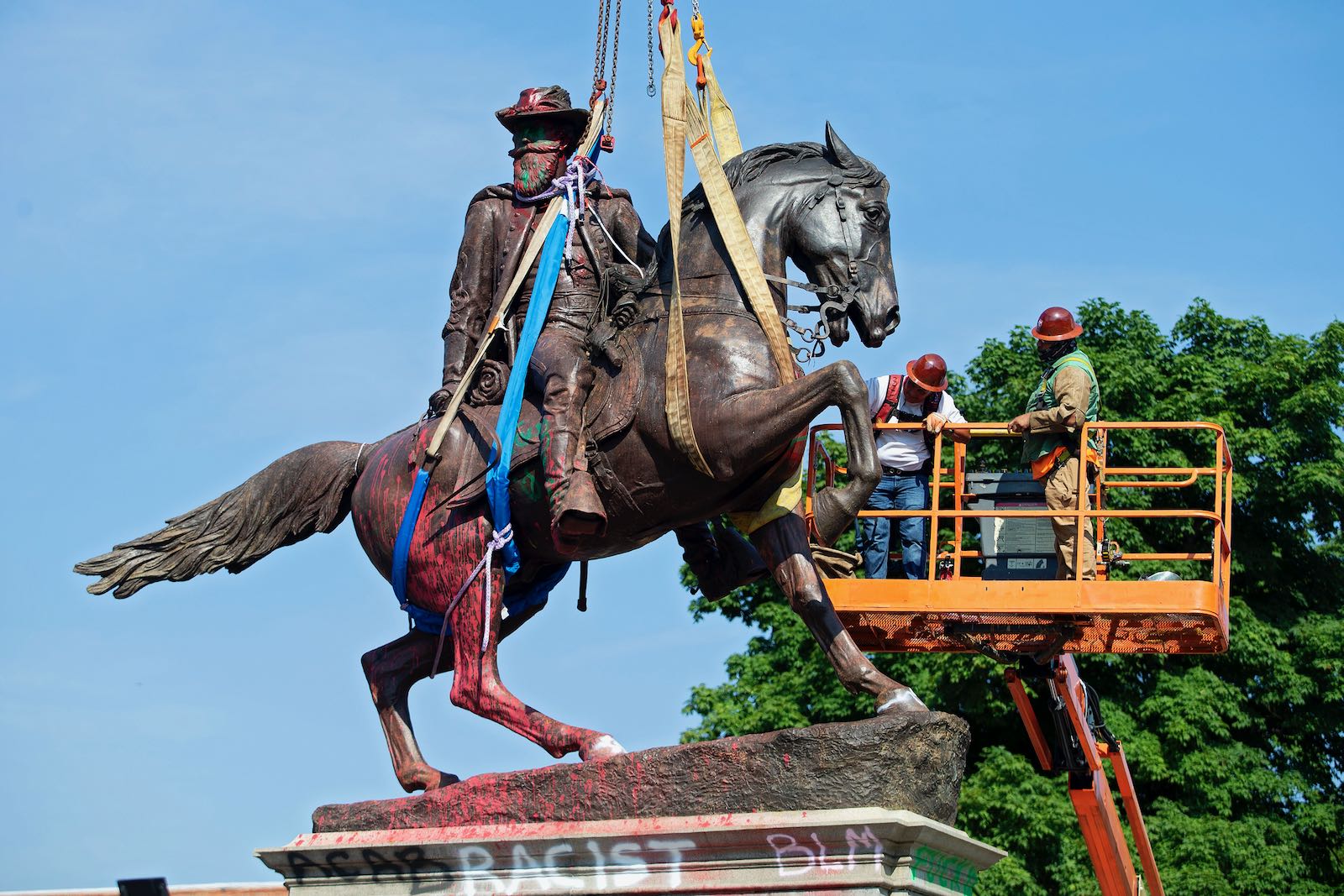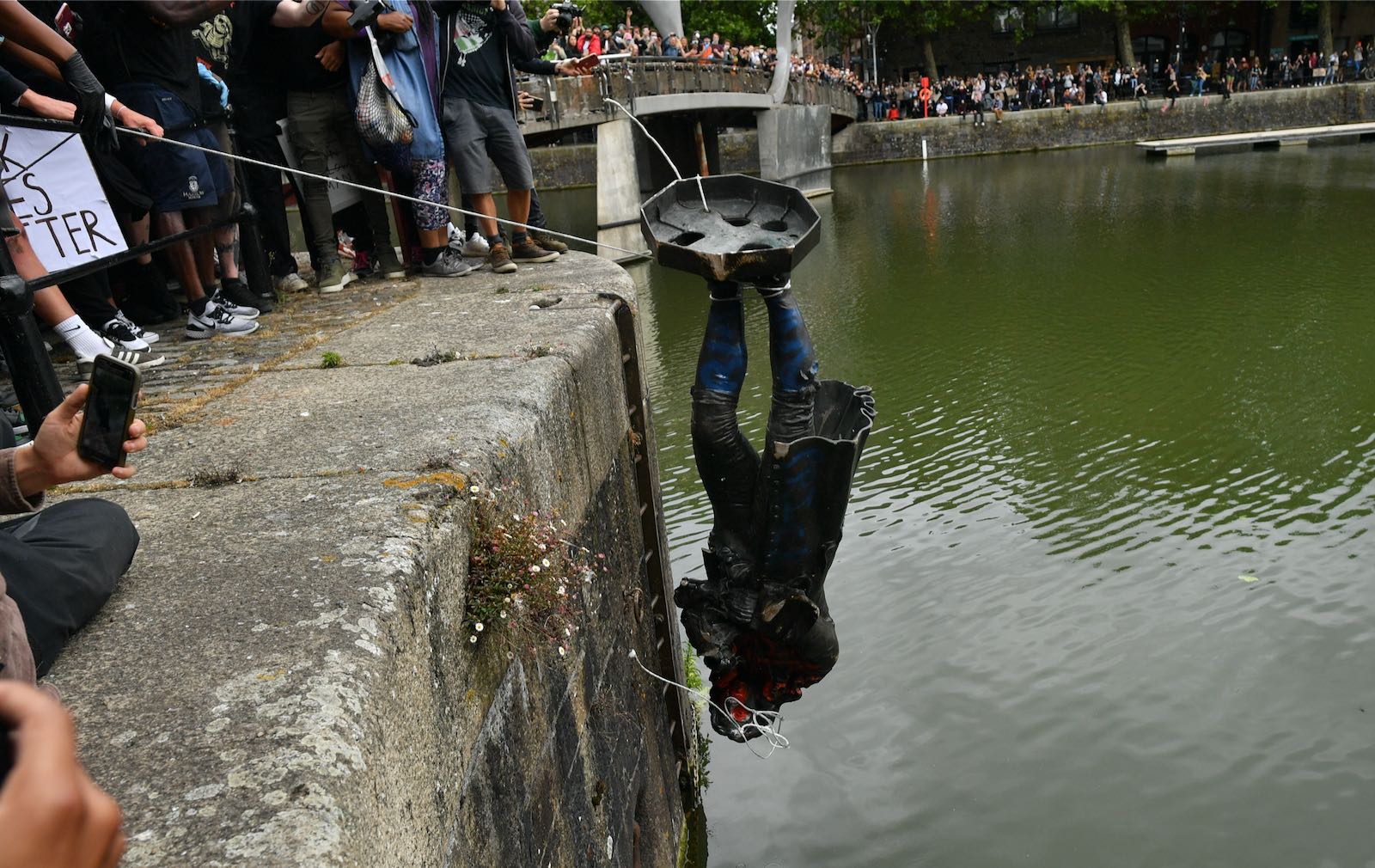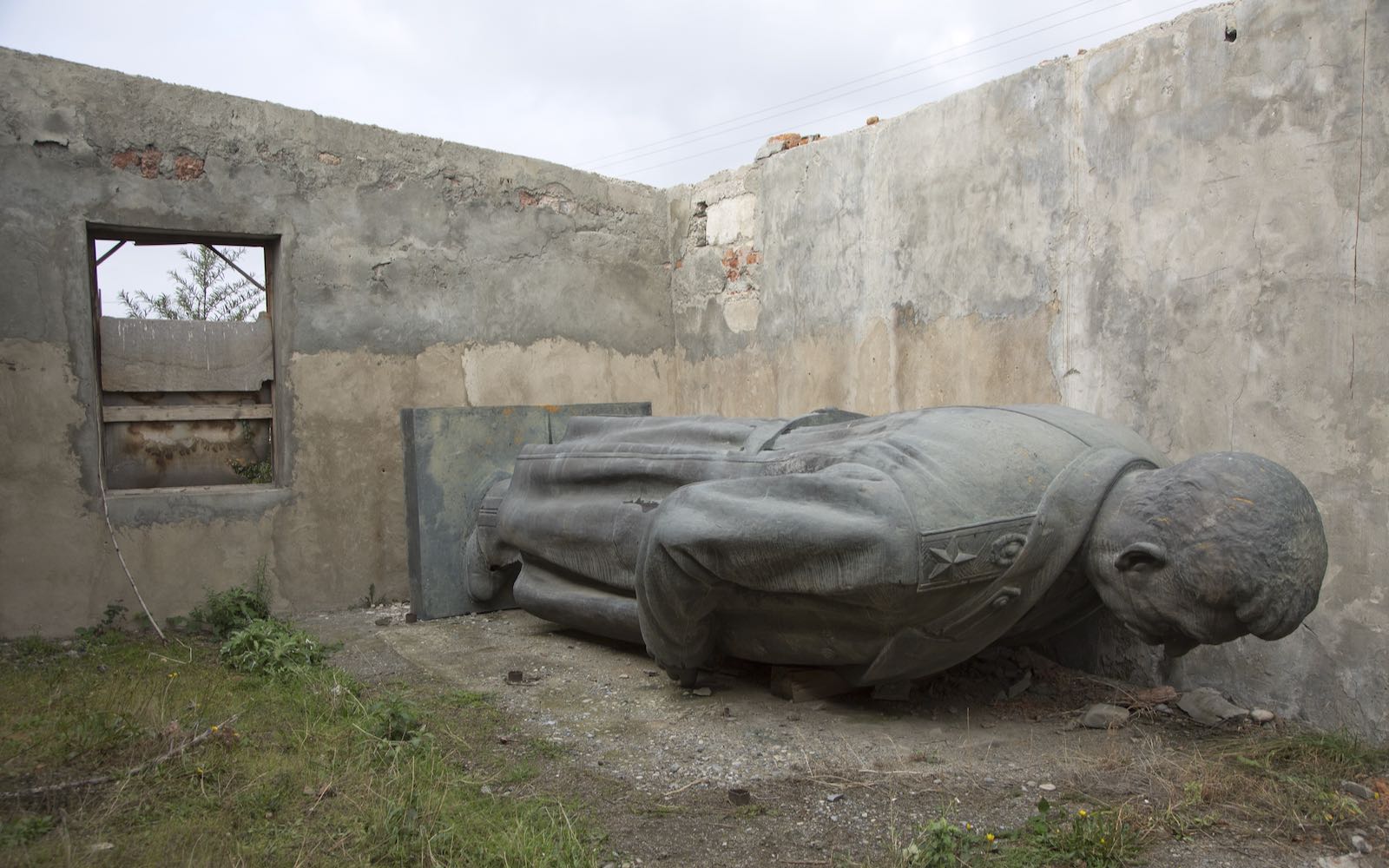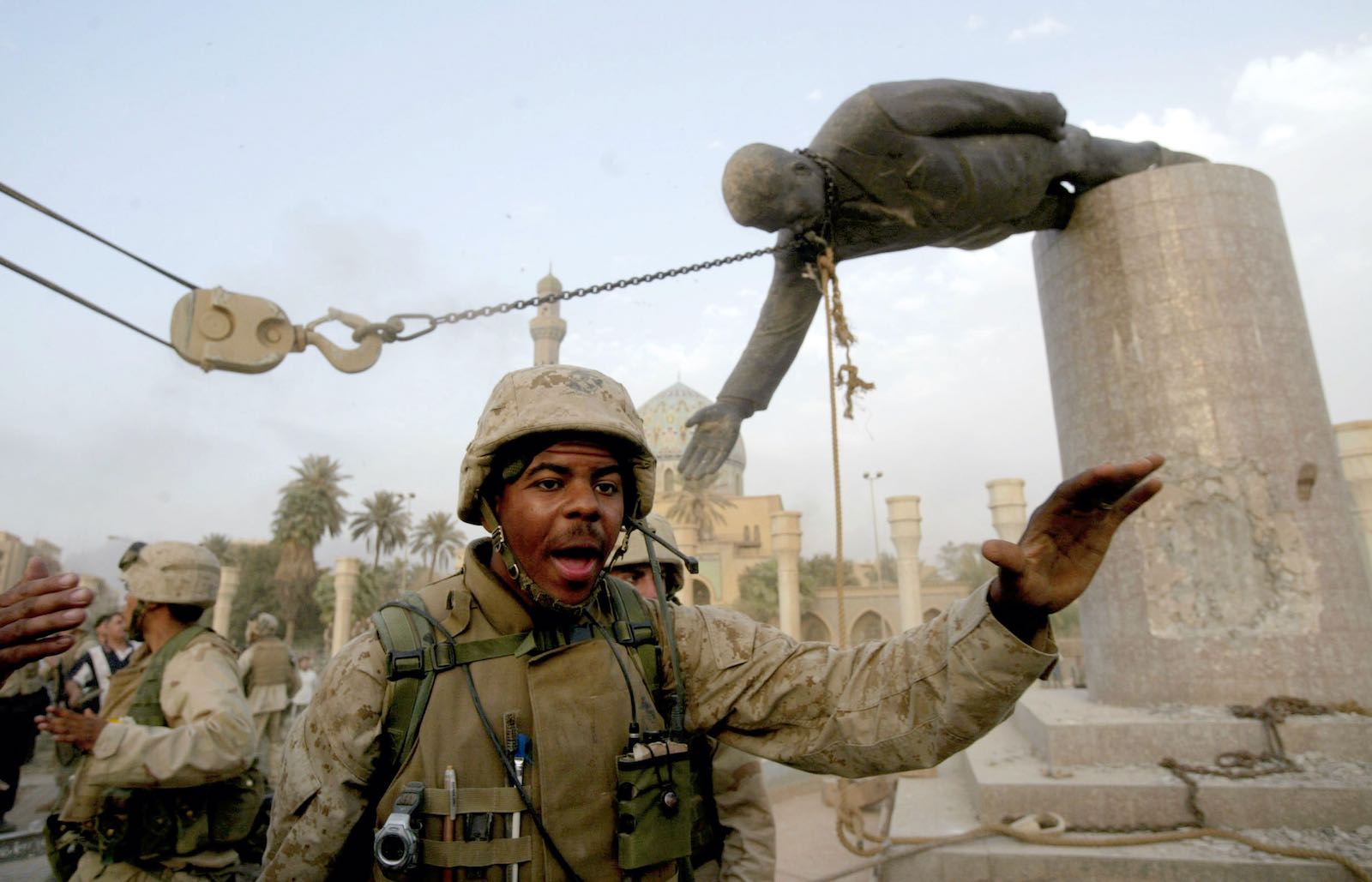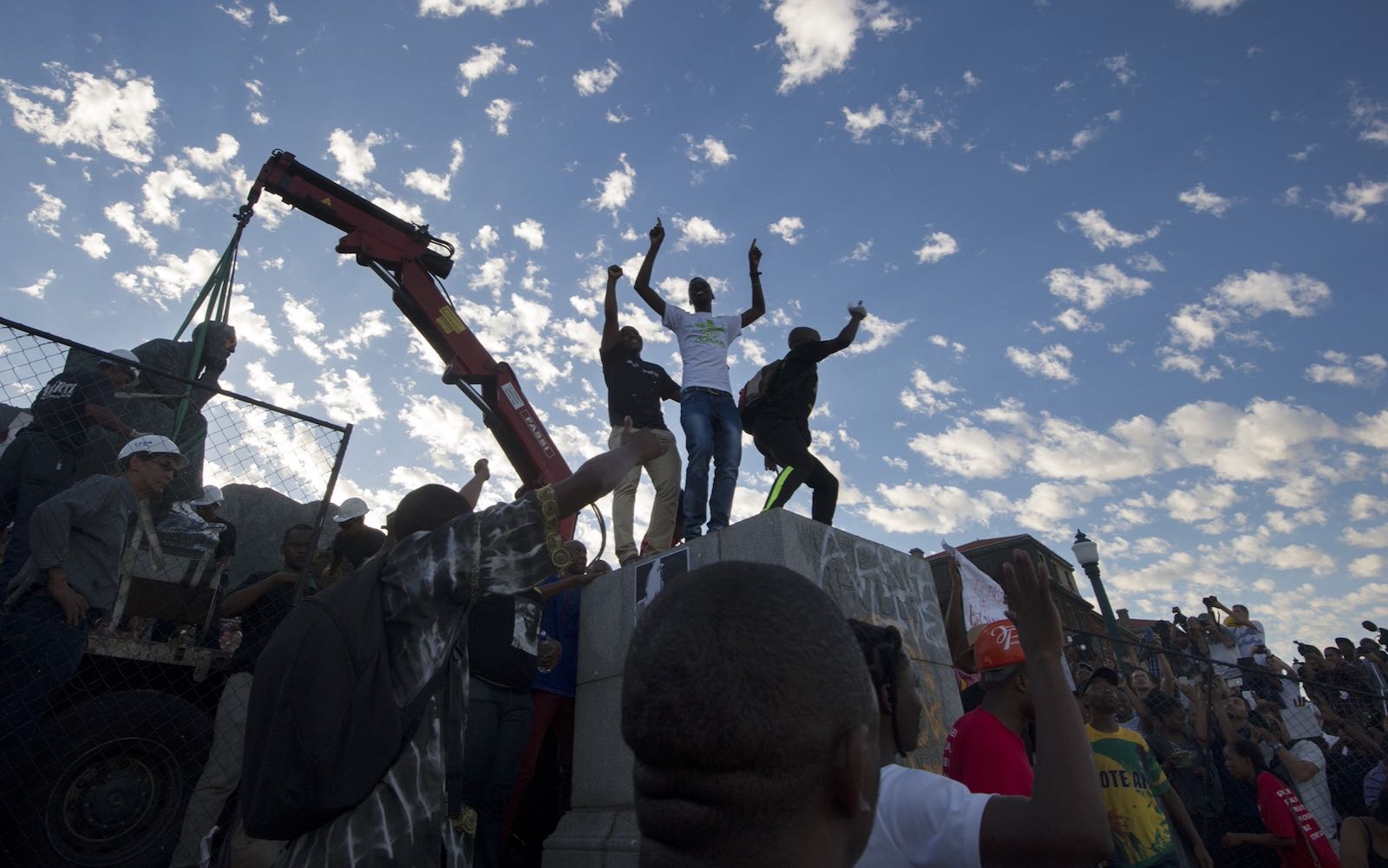“We stand today at the national center to perform something like a national act—an act which is to go into history.”
So said the great nineteenth-century former slave and staunch abolitionist Frederick Douglass at the unveiling of the Emancipation Memorial in Lincoln Park, Washington, D.C., in 1876. “That we are here in peace today,” Douglass told a crowd of almost 25,000, many of them African-American, “is a compliment and a credit to American civilization, and a prophecy of still greater national enlightenment and progress in the future.”
The idea for the memorial had come originally from former slave Charlotte Scott, of Virginia, who wanted a monument in honor of Abraham Lincoln. She gave five dollars to begin a funding drive, and the monument was eventually paid for entirely by former slaves.
Almost a hundred and fifty years later, many African Americans feel differently about the memorial. In June, Black Lives Matter protesters attempted, unsuccessfully, to topple the statue. D.C. Congresswoman Eleanor Holmes Norton vowed to introduce legislation to have the memorial removed. The Boston Art Commission unanimously resolved to take down a copy of the statue in Boston.
Some critics of the statue view Lincoln as a false friend of African Americans. Others see the statue itself as demeaning, with Lincoln represented as standing upright, while the free black man is on his knees. For defenders of the statue, on the other hand, to remove it is to erase a memorial paid for by former slaves and anointed by Douglass. It is to besmirch black history itself.
What is striking in this contemporary debate is that there is nothing new about it. It goes back to the very creation of the monument. Douglass, even in his dedication speech, expressed his ambivalence about Lincoln. “Abraham Lincoln was not,” he observed, “in the fullest sense of the word, either our man or our model. In his interests, in his associations, in his habits of thought, and in his prejudices, he was a white man.” He continued:
To protect, defend, and perpetuate slavery in the states where it existed, Abraham Lincoln was not less ready than any other President to draw the sword of the nation. He was ready to execute all the supposed guarantees of the United States Constitution in favor of the slave system anywhere inside the slave states. He was willing to pursue, recapture, and send back the fugitive slave to his master, and to suppress a slave rising for liberty, though his guilty master were already in arms against the Government.
And yet, he acknowledged, “while Abraham Lincoln saved for you a country, he delivered us from a bondage, according to Jefferson, one hour of which was worse than ages of the oppression your fathers rose in rebellion to oppose.”
Today’s controversies over statues of racists and slave owners have a more recent backstory, too. In March 2015, a South African activist named Chumani Maxwele smeared excrement on a statue of Cecil Rhodes at the University of Cape Town. So began the “Rhodes Must Fall” campaign. The following month, the university authorities removed the statue. Rhodes Must Fall became an international cause and popular Twitter hashtag. The campaign took root most notably in Oxford, Britain, where another statue of Rhodes had stood for over a century, above an entrance to Oriel College, to which he left £100,000 in his will.
A parallel campaign developed meanwhile against Confederate statues in the US. While there have long been campaigns against such memorials, the moves to take them down acquired a new intensity after the white nationalist rally in Charlottesville in 2017. That year, thirty-six Confederate monuments were removed. This year, amid the rekindled Black Lives Matter protests that erupted after the killing of George Floyd in Minnesota in May, another thirty at least have come down.
As the protests went global, demonstrators in Bristol, England, toppled a statue of a slave trader named Edward Colston and dumped it in the docks. That acted as a catalyst for the release of pent-up fury: the following day, in London, the statue of slave trader Robert Milligan was removed from outside the Museum of London Docklands by the public trust responsible for the site. Then protests erupted in Belgium, where statues of King Leopold II, under whose rule the Congo had been turned into a brutal slave camp in the late nineteenth century, were defaced and taken down. This wave of iconoclasm moved again back across the Atlantic, where not just Confederate memorials but statues of Columbus, Jefferson, Washington, and others were toppled.
At the heart of all this lie two fundamental questions: What do statues, and their removal, tell us about the past—and the present? And what do the campaigns against statues tell us about the struggle to confront racism?
Critics of the toppling campaigns condemn what they regard as the rewriting of history. After demands for the removal of a statue of Winston Churchill in Parliament Square, British Prime Minister Boris Johnson—himself a biographer of Churchill—tweeted: “We cannot now try to edit or censor our past. We cannot pretend to have a different history.” To remove statues would be “to lie about our history, and impoverish the education of generations to come,” he said.
The British-based American historian Christopher Phelps rejects such claims, arguing that removing statues is little different from the normal practice of history. “To reconsider, to recast, is the essence of historical practice,” he wrote in The Chronicle of Higher Education in January. “It follows that altering how we present the past through commemorative symbols is not ahistorical. It is akin to what historians do.” Removing statues “does not vitiate history,” he insisted; “on the contrary, it represents a more thorough coming to terms with the past and its legacies, a refusal to forget.”
Statues are rarely about history as such; they are about memory. That is, they are part of the process of shaping perceptions of history. That is why they have long been sites of contestation, and not just in the present.
*
The story of Edward Colston’s statue in Bristol highlights the way that statues make concrete—or marble or bronze, so to speak—the attempt to memorialize a particular historical narrative. Colston was a Bristol-born merchant who made his fortune in large part from the slave trade. Upon his death, he left much of his wealth to charities.
The statue of Colston was not erected, however, during his lifetime. Nor even in the aftermath of his death. It was put up almost two centuries after he had died. And that memorialization had less to do with Colston himself than with fears about growing class tensions in Bristol. In the 1890s, there was in Bristol, as elsewhere in industrial Britain, considerable working-class discontent and union agitation. More than a decade of economic recession, low wages, and poor working conditions, combined with continued disenfranchisement of large sections of the working class, led to waves of strikes and a series of bloody confrontations between workers and police.
Against this background of escalating strife, city leaders, both in politics and business, decided to erect a statue of a philanthropic businessman to act as a symbol of civic pride. Various names were proffered as suitable candidates. Bristol’s elite settled on Colston. His involvement in slavery was seen not as a matter of shame but almost as a badge of pride at a time that saw the emergence of a new age of high imperialism, exemplified by the “Scramble for Africa” in the final decades of the nineteenth century. This was a period, too, in which the notion of the racial superiority of the British people evolved from being an elite ideology to become part of patriotic popular culture, celebrated in mass circulation newspapers, penny-dreadful novels, and popular entertainment. For Bristol’s ruling class, Colston’s statue was an attempt to use myths of Britain’s racial superiority to defuse disaffection at home.
Confederate statues in America served a different political purpose, but they were equally about ransacking the past to serve the needs of the present. There are, according to the Southern Poverty Law Center, 780 Confederate monuments or statues in the US, almost half of which are in three states: Georgia, Virginia, and North Carolina. Most of these monuments were erected not in the immediate aftermath of the Civil War, which ended in 1865, but between the 1890s and the 1950s, the era of Jim Crow segregation. Most were, in fact, installed in the first two decades of the twentieth century, when the Jim Crow system was still being established in the American South. There was a smaller spike in the 1950s and 1960s, as part of the backlash against the civil rights movement and desegregation.
Maryland remained in the Union during the Civil War. While it was a slave state—both Frederick Douglass and Harriet Tubman were born into slavery in Maryland—almost half of African Americans in the state were free, and it boasted the largest number of free blacks in any US state. Thousands of Marylanders fought for the Confederacy, but almost three times as many took up arms for the Union. In the twentieth century, however, three Confederate statues were erected in Baltimore, the state’s most important city, including one honoring Generals Robert E. Lee and Stonewall Jackson built as late as 1948. They were not commemorating the history of Maryland, or of the Civil War, but rewriting the history of the war as a just and moral struggle, to justify the present-day denial of rights to African Americans as also just and moral.
Advertisement
What statues of Colston and Lincoln, of Churchill and Lee, tell us, then, is less about these figures themselves than about how later generations wanted to retell their stories in a way that buttressed the demands and desires of a particular elite. The fact that statues are not straightforward expressions of history, but ways of shaping memory, is not, though, an argument that necessarily makes their removal more valid. The arguments for taking down statues are often as ragged as those for retaining them.
Histories and biographies are both complex narratives, rarely cleaving to “good” and “bad.” On both sides of the statue debate, there is a reluctance to acknowledge that complexity, and a tendency to look only upon one aspect of a historical figure, whether good or bad, and to make that the only issue worth discussing. Figures such as Churchill or Jefferson have long been celebrated for their great deeds, while their despicable acts or immoral views were overlooked or ignored. Many in Britain have still not heard of the Bengal Famine, or of Churchill’s role in it, or know little of the brutal reality of the British Empire. More people in America probably know of Jefferson’s slaveholding, but until recently, it has barely figured in national discussions.
National and imperial history has long been whitewashed, and the sordid, immoral aspects of the lives of revered historical figures have often been airbrushed. That does not mean, however, that critics of such history should themselves adopt a one-eyed view—that we should damn Churchill or Jefferson for the deplorable aspects of their lives or views without also considering either the historical context or their other qualities that might make them historically significant.
Even those usually seen as progressive figures often held deeply regressive attitudes. William Wilberforce, for instance, is generally celebrated for his campaigning against slavery, yet he was also hostile to working-class suffrage and believed that trade unions should be suppressed. Leading Suffragettes such as Emmeline Pankhurst supported eugenics. Gandhi expressed racist views about black Africans during his early career in South Africa: because of this, a statue of him was removed from the University of Accra, in Ghana, in 2018, and there have been calls for another statue of him to be removed from Leicester, England, and for one not be erected in Manchester. The demand that we should only celebrate or honor those without moral stain is a demand for a fantasy world expunged of all moral complexity.
There is nothing wrong in principle in removing statues: icons are created, icons are torn down—this has happened throughout history. Moral complexity may be an argument against unthinking iconoclasm. It is not, however, an argument for never taking down statues. What we should avoid, though, is mirroring the kind of cartoonish history embodied in many of these statues by viewing them as tropes for good and bad. No human is entirely saintly; few are without redeeming qualities. There can be no hard and fast rules to justify iconoclasm, only judgments.
Some contemporary iconoclasts argue that they are not interested in parsing the character of historical figures, but simply want to redefine how we view history. The toppling of statues is a symbolic act of destruction “to liberate the past” from the control of the powerful, and to begin “rethinking it from the point of view of the ruled and the vanquished, not through the eyes of victors.”
There is, though, no single way of rethinking history “from the point of view of the ruled and the vanquished.” The historical significance of the American Revolution, the legacy of the American Civil War, Gandhi’s social attitudes—all are matters of fierce debate, not just between the powerful and the masses, but among “the ruled and the vanquished,” too. Those debates demand a more nuanced view of history and biography; to balance, as Douglass does, Lincoln’s willingness to “protect, defend, and perpetuate slavery in the states where it existed” with his leadership in the Civil War, not to ignore Jefferson’s slaveholding and attitudes to black people but equally not to forget the part he played in the Revolution, to acknowledge both Gandhi’s racist views of black Africans and his accomplishments in the struggle for Indian independence. Not to do so—to focus solely on Jefferson’s slaveholding, say, or on Gandhi’s racism—would be to mimic the actions of those who first erected statues as a means of imposing their stamp on historical memory.
This is not an argument for moral relativism. It is possible and necessary to distinguish between historical figures defined predominantly by their racism or their slaveholding, or those whose statues were constructed primarily as a way of intimidating certain groups, from others whose lives are more variegated, in part to be deprecated, in part to be honored. This is a way of making a distinction between the memorialization of Colston and Lee, say, and that of Jefferson and Gandhi. At the very least, this offers a way of opening up public debate on these issues rather than shutting it down by insisting on a singular view of the past.
Of course, coming to some consensus on such issues is not easy. In Bristol, for instance, there had earlier been an acceptance that the best solution to the Colston statue might be to leave it standing but replace the plaque with one that gave a fuller, more critical account of his life. There were, though, fierce disagreements over what the new plaque should say. In the end, the protesters made their own decision, foreclosing that debate.
Most statues were erected on the say-so of a particular elite to promote a self-serving historical narrative. What we should be wary of, now, is for any decision to be taken by a backroom committee, or by a government body, or even by a single group of protesters. Deciding what to do with those statues now should not be the work of any group that might represent only a small part of the community. That would merely be to replace the wishes of a historical elite with those of an equally unrepresentative contemporary group.
*
The second question at the heart of contemporary iconoclasm concerns what these campaigns tell us about the struggle to confront racism. There are two main arguments about why the removal of statues of racists or slavers may be a necessary part of the battle against racism. First, that statues of racists or enslavers or colonizers are demeaning or hurtful to black people and other marginalized groups, who cannot feel they truly belong in a society that maintains such symbols of degradation. And second, that statues express the values of a society. Any society that takes seriously its disavowal of racism must, iconoclasts argue, also remove any symbols or embodiments of such racism.
It is not difficult to see why a statue of Rhodes in South Africa might cause anger, nor why African Americans might resent Confederate statues designed to symbolize the enforcement of white supremacy. And yet, we should be careful about pushing this argument too far. There is a danger of slipping from the rightful claim that certain monuments or forms of social symbolism can create unwelcoming environments for marginalized people into an assumption that black people are psychologically fragile, replacing a language of resilience and rights with one of trauma—that, as one supporter of the #Rhodesmustfall campaign claimed, “seeing Rhodes so recognised is a deep wound.”
Certainly, the past shapes the present and history can mold our emotions. But marginalized groups are not trapped by their history; nor is that history the cause of unending psychological trauma. It would be disastrous if anti-racists today were led to argue so, or to invest the past with too great a power over the present.
Monuments, it is true, are designed to shape memory and to use the past to engage in the struggles of the present. But this should not lead inevitably to the conclusion that statues embodying values no longer held by society should come down.
All history is a conversation between the present and the past. Over time, that conversation necessarily changes, as the figures and events that we regard as significant, and the reasons for viewing them as significant, change. And as the conversation changes, so does the meaning of statues (or any cultural artifact, whether literary, musical, or architectural). It’s not just that historical research may unearth new facts about the lives of Colston or Rhodes or Jefferson; it’s also that the meaning we attribute to those facts shifts.
From this perspective, statues of Colston or Rhodes or Jefferson tell us not just that these men were racists or imperialists or slaveholders, but also how far we have moved from the days in which our societies celebrated racists or imperialists or slavery. The very fact that we are having this debate is a demonstration of that distance. The issue is as much about how we read statues and monuments as about what is symbolically written into them.
Traditionally, most forms of iconoclasm occur either because rulers are trying to shore up their own power by expunging rivals from the record or because the masses have moved to overthrow an old regime. The earliest recorded case of someone being physically anulled from the historical record is probably that of Hatshepsut, a female pharaoh in the fifteenth century BCE. Her successor, Thutmose III, attempted to erase her from public memory by ordering her statues to be torn down and her image to be chiseled off stone walls. In modern times, from the French Revolution to the dismantling of the Soviet empire, statues have often been toppled en masse by popular outrage upon the removal of a reviled regime.
Today’s iconoclasm is different, falling into neither of these traditional categories. Rather, the taking down of statues has become a goal in itself, as an act of social transformation. The danger arises if the symbolic act comes to replace material change. The South African activist Siya Mnyanda, a former student at the University of Cape Town, wrote in 2015 wishing that “the same amount of energy that has been used to campaign for #Rhodesmustfall” had been expended on “fighting for a more just and sound education system, better access to student funding and the building of more universities promised by the government.” Dena Latif, a black student at Oxford University, has similarly argued that the campaign became a form of displacement: “My problem with it lies in the use of an old statue as a symbol of Oxford’s racism. Why do people have to look 150 years into the past to see the issue?” The American historian Cheryl Hudson insists that “Campaigners are deluding themselves if they think that removing a flag or statue will make any difference to inequalities of race, class or gender.”
The debate over statues—and the wider debates around the Black Lives Matter movement—have thrust the issue of our relationship to history into public consciousness. We should seize this moment to think more deeply about the complexities of the past that have shaped the present. To recognize, for instance, that the Enlightenment was crucial to the development of progressive social ideals, laying the ground for modern ideas of equality and liberty, but also that, through slavery and colonialism, these ideals were denied to the majority of people across the globe, and their lives were often ripped apart in the most grotesque ways, and their societies degraded. To recognize, too, that the same historical figures—such as Locke, Jefferson, Pankhurst—could stand on both sides of this equation.
Perhaps the best way to express the changing attitudes toward the past is not necessarily to tear down statues, but to put up new ones that allow us to acknowledge the complexities of history. Frederick Douglass himself was of this view. Days after he had spoken at the dedication of the Emancipation Memorial in Lincoln Park, he wrote a letter—only recently unearthed—to the National Republican newspaper. In it, he aired his own misgivings about that statue. “The negro here, though rising, is still on his knees and nude,” he wrote. Douglass went on to suggest that there was room for another memorial in Lincoln Park:
What I want to see before I die is a monument representing the negro, not couchant on his knees like a four-footed animal, but erect on his feet like a man.


